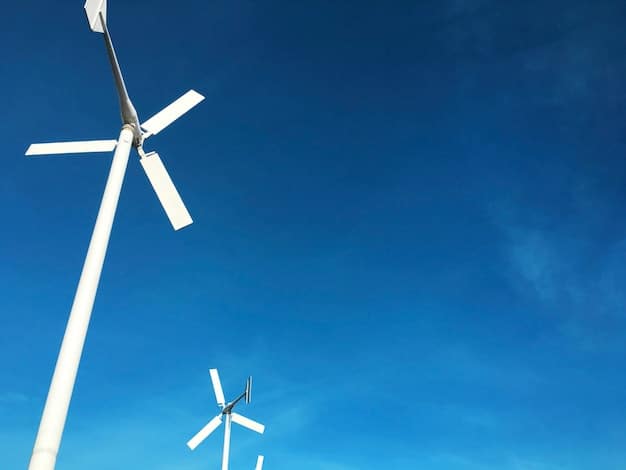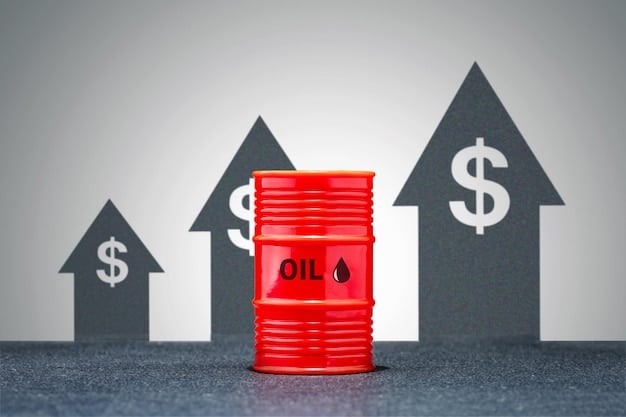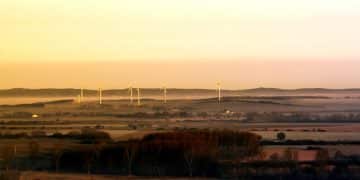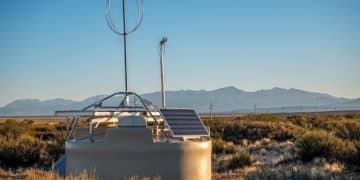US Climate Bill: Analyzing the Economic Impact of Climate Change News

Climate Change News: Analyzing the Impact of the New US Climate Bill on the Economy reveals that the Inflation Reduction Act aims to significantly reduce carbon emissions and invest in renewable energy, sparking debates over its potential effects on job creation, energy prices, and overall economic growth in the United States.
The landscape of climate change policy in the United States has undergone a seismic shift with the introduction of the new US Climate Bill. Understanding the economic implications of this bill is crucial. Let’s delve into how this legislation may reshape the American economy.
Understanding the New US Climate Bill
The new US Climate Bill, officially known as the Inflation Reduction Act, represents the most significant climate legislation in US history. It aims to dramatically reduce carbon emissions and invest massively in clean energy technologies.
The bill is designed to propel the US towards its climate goals by 2030. The framework includes investments in renewable energy, electric vehicle adoption, and carbon capture technologies. The implications for businesses, consumers, and the environment are broad and complex.
Key Provisions of the Bill
The bill encompasses various mechanisms to achieve its environmental goals. These provisions have far-reaching consequences for different sectors of the economy.
- Tax Credits for Renewable Energy: Incentivizes investments in solar, wind, and other renewable energy projects.
- Electric Vehicle Subsidies: Offers tax credits to encourage the purchase of electric vehicles, reducing reliance on fossil fuels.
- Grants for Carbon Capture Technology: Supports the development and implementation of technologies that capture carbon emissions from industrial sources.
- Methane Emissions Reduction Program: Targets methane emissions from the oil and gas industry.
By implementing these provisions, the climate bill seeks to accelerate the transition to a cleaner, more sustainable economy. The economic impacts are expected to be substantial and multifaceted.
In summary, this initial section highlights the core objectives and key components of the new US Climate Bill. The focus is on understanding the legislation’s framework and its intended environmental and economic outcomes. Understanding lays the foundation analysis on economic impact.

Impact on Renewable Energy Sector
One of the most direct impacts of the new US Climate Bill is on the renewable energy sector. With substantial tax credits and incentives, investment in solar, wind, and other renewable energy sources is expected to surge.
This influx of capital can stimulate innovation, drive down costs, and create more jobs in the sector. However, challenges remain in scaling up renewable energy infrastructure and integrating it into the existing power grid.
Job Creation in Renewable Energy
The growth of the renewable energy sector as a positive impact of climate bill. New jobs will be created in manufacturing, installation, and maintenance of renewable energy systems.
- Manufacturing: Increased demand for solar panels, wind turbines, and related components will boost domestic manufacturing.
- Installation: Renewable energy projects require skilled workers for installation and setup.
- Maintenance: Ongoing maintenance and repairs of renewable energy infrastructure will create long-term employment opportunities.
These job opportunities can help offset potential job losses in fossil fuel industries. The transition will require training and support programs to ensure a smooth workforce transition.
Challenges in Scaling Up
Scaling up renewable energy infrastructure faces challenges. Overcoming these hurdles is crucial for achieving the bill’s climate goals.
- Infrastructure Limitations: Expanding transmission lines and grid storage capacity is necessary to handle increased renewable energy output.
- Supply Chain Constraints: Ensuring a reliable supply chain for critical components like solar panels and battery storage devices is essential.
- Regulatory Hurdles: Streamlining permitting processes for renewable energy projects can accelerate deployment.
Addressing these challenges is vital to the successful expansion of the renewable energy sector. Strategic investments and policy reforms can help overcome these barriers.
In brief, the renewable energy sector stands to benefit significantly from the new US Climate Bill. This section highlights the potential for job creation and the challenges associated with scaling up renewable energy infrastructure. Overcoming these hurdles is crucial for achieving the bill’s climate goals.
Effects on the Fossil Fuel Industry
In contrast to the renewable energy sector, the fossil fuel industry faces increased pressure under the new climate bill. Policies aimed at reducing methane emissions and phasing out oil and gas subsidies may lead to economic challenges for companies in this sector.
However, the bill also includes provisions for carbon capture technologies, offering a potential pathway for fossil fuel companies to adapt and reduce their environmental impact. The transition will require strategic planning and diversification.
Potential Job Losses
The shift away from fossil fuels may result in job losses in coal mining, drilling, and related industries. Addressing this possibility will require implementing retraining programs and support services.
The goal is to empower workers to transition to new roles in the burgeoning clean energy sector. Proactive measures are critical to mitigating the social and individual impacts of job displacement.
Opportunities in Carbon Capture
The bill supports innovations for fossil fuel companies to invest in carbon capture technologies. These technologies capture CO2 emissions from power plants and industrial facilities, preventing them from entering the atmosphere.
This provides fossil fuel companies with an opportunity to reduce their carbon footprint and maintain operations. Investment in carbon capture can also create new jobs in engineering, construction, and operation of these facilities.
The new US Climate Bill presents both challenges and opportunities for the fossil fuel industry. The focus is on understanding the potential for job losses and the possibilities offered by carbon capture technologies. Mitigation of negative impacts and transition of the workforce are significant objectives.
Impact on Consumers and Energy Prices
The new US Climate Bill will affect energy prices and consumer spending through various channels. Subsidies for electric vehicles and energy-efficient appliances can lower costs for consumers in the long run.
However, the transition to cleaner energy sources may also lead to short-term price fluctuations and increased energy costs. Understanding these dynamics is essential for policymakers and consumers.
Subsidies and Tax Credits
The bill offers significant subsidies and tax credits for consumers, encouraging the adoption of clean energy technologies by reducing initial costs.
- Electric Vehicles: Tax credits for purchasing electric vehicles can make them more affordable for consumers.
- Energy-Efficient Appliances: Rebates for energy-efficient appliances can lower energy bills and reduce overall energy consumption.
- Home Energy Efficiency: Incentives for home energy audits and upgrades can help homeowners save money and reduce their carbon footprint.
With the help of these incentives, consumers are empowered to make sustainability choices. The resulting decrease in energy consumption contributes to the bill’s climate objectives.
Potential Price Fluctuations
The transition to renewable energy sources may bring about temporary price fluctuations. Factors include variability in renewable energy supply, infrastructure improvements, and changing energy demand.
- Renewable Energy Variability: Solar and wind energy sources depend on weather conditions, which can affect energy supply and prices.
- Infrastructure Investments: Grid upgrades and expansion may require costs that are passed on to consumers.
- Changing Energy Demand: Shifts in energy demand patterns can influence energy prices both positively and negatively.
Careful monitoring and strategic policies can help mitigate price volatility. Ensuring a stable and affordable energy supply remains a priority throughout the transition.

In conclusion, the new US Climate Bill holds significant implications for consumers and energy prices. While subsidies can lower costs and promote sustainability, the transition may bring about price fluctuations. Managing these dynamics is key to ensuring a smooth and equitable energy transition for all Americans.
Long-Term Economic Growth and Productivity
The long-term economic growth of the US is related to the effects of the new climate bill. Investments in clean energy and sustainable technologies could stimulate innovation, enhance productivity, and create new industries.
However, the bill’s impact on economic growth is subject to ongoing debate. The goal is sustainable economic growth, as well as environmental protection.
Innovation and Technological Advancement
The bill is designed to drive innovation in clean energy and sustainable technologies. Innovation can bring about economic growth and competitiveness.
The development of new technologies and sustainable practices can also enhance productivity. Efficient energy systems and resource management can reduce costs and improve overall economic performance.
Debates on Economic Growth
The new climate bill’s impact on economic growth has been debated among economists and policymakers. Some argue that the bill’s investments in clean energy can drive long-term economic growth. Others fear that regulations and costs could hinder economic progress.
Achieving sustainable economic growth requires careful consideration of various factors. Balancing environmental protection with economic development is a complex but achievable goal.
The long-term economic growth of the US is closely tied to the outcomes of the new US Climate Bill. The focus is on innovation and technological progress. Sustainable growth is a complex goal, with benefits for both the economy and the environment.
Global Implications and US Leadership
The new US Climate Bill has implications for global climate action and the role of the United States as a leader in international efforts. Commitments to reduce emissions and invest in clean energy can inspire other countries to follow suit.
The bill can promote collaboration and technology transfer, accelerating the transition to a low-carbon future. International leadership is essential for the global response to climate change.
Influence on Global Climate Action
US climate commitments influence global climate action, particularly for nations to strengthen their climate policies.
The new bill can also foster collaboration among countries. Shared knowledge and resources are essential for addressing this global challenge.
Promoting Technology Transfer
The US has a strong influence on international efforts to combat climate change. With a strong economy, investment in R&D will accelerate technology transfer for adapting to a low carbon future.
By sharing its expertise and resources, the US facilitates global progress. International cooperation is vital for speeding up the global transition to a low-carbon economy.
The new US Climate Bill is meaningful for international dynamics in climate action. The focus has been on US commitment to inspire global action and technology transfer. The global efforts of the United States toward climate change have global impact.
| Key Aspect | Brief Description |
|---|---|
| 🌱 Renewable Energy Surge | Significant tax credits boosting solar, wind & other renewables investment. |
| 🏭 Fossil Fuel Challenges | Increased regulations and reduced subsidies present economic hurdles. |
| 💰 Consumer Impacts | Subsidies on EVs & energy-efficient appliances, balancing long-term gains with short-term costs. |
| 🌍 Global Leadership | US commitments inspiring global climate action & technology transfer. |
Frequently Asked Questions
▼
The primary aim is to significantly reduce carbon emissions in the United States by 2030 through investments in renewable energy and clean technologies.
▼
The bill is expected to boost investment and create jobs in the renewable energy sector through tax credits and other incentives for solar, wind, and related projects.
▼
The fossil fuel industry may face economic challenges due to reduced subsidies and increased regulations, although carbon capture technologies offer potential opportunities.
▼
Consumers can benefit from subsidies for electric vehicles and energy-efficient appliances, but may also see short-term fluctuations in energy prices.
▼
The bill enhances US leadership in global climate efforts and can inspire other nations to strengthen their commitments and collaborate on climate action.
Conclusion
In conclusion, the new US Climate Bill represents a pivotal moment in the nation’s approach to addressing climate change. While the economic impacts are varied and complex, the potential benefits for renewable energy, technological innovation, and global leadership position the United States as a key player in the global transition to a sustainable future. Navigating the challenges and maximizing the opportunities presented by this bill will be vital for long-term economic and environmental prosperity.





